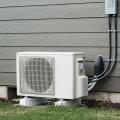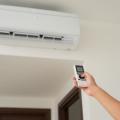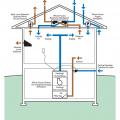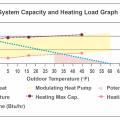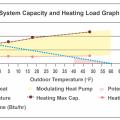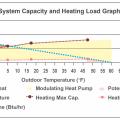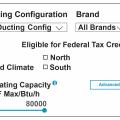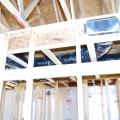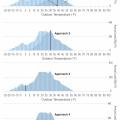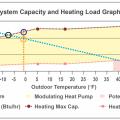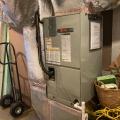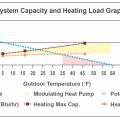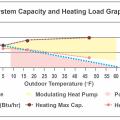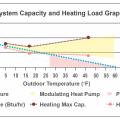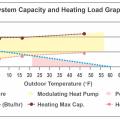Showing results 1 - 25 of 25
Ductless indoor units like this one are controlled individually by handheld remote controllers.
In heating mode, split system heat pumps absorb heat from the outside air and “pump” that heat to the indoor air handler unit, which releases it to the inside air.
Right (decent): For a relatively high-capacity ccASHP sized per Approach 3 or 4 to meet nearly 100% of the heating load, this heat pump’s modulating zone has a decent overlap with the home’s heating load line, reducing short-cycling.
Right: Sized per Approach 1, this heat pump will have minimal short-cycling; since sized using Approach 1, it will require backup heat when temp is below 30°F but could still contribute significant heating down to heating design temp (-6°F) and lower
Right: Sized per Approach 3 or 4, this heat pump’s modulating zone has a large overlap with the home’s heating load line, resulting in minimal short-cycling; the unit may require a small amount of backup heat during the very coldest hours of winter.
Right: Sized per Approach 3, this heat pump’s modulating zone has a large overlap with the home’s heating load line; it will require backup heating but could still contribute significant heating for all hours of the heating season
The high-efficiency mini-split heat pump provides cooling and heating; a drain pipe carries condensate away to a location that meets local code requirements.
The NEEP Cold Climate Air Source Heat Pump List allows users to search, sort, and filter for cold climate heat pumps by brand, model, product type, and ducting configuration; an advanced search provides helpful resources for sizing to the heating load
These ducts were installed within the home's conditioned space in a central chaise down the main hallway.
These plots compare sizing approaches in terms of the approximate annual heating load a heat pump might carry throughout the year for a hypothetical home in Minneapolis, MN.
This “high static ducted cassette” heat pump system is similar to a traditional centrally ducted system, serving several areas of a home from one indoor unit
This multi-split heat pump system incorporates several indoor units connected to just one outdoor unit; the indoor units include a wall-mounted unit, floor-mounted, ceiling cassette, and mini-air handler.
This plot shows a heat pump’s minimum and maximum cooling capacities overlaid with a home’s cooling load line, allowing a designer to assess how well-suited the equipment is for the specific home.
This plot shows a heat pump’s minimum and maximum heating capacities overlaid with a home’s heating load line as well as the annual heating load hours for the home, allowing a designer to assess how well-suited the equipment is for the specific home.
This plot shows a heat pump’s minimum and maximum heating capacities overlaid with a home’s heating load line, allowing a designer to assess how well-suited the equipment is for the specific home.
This plot shows a heat pump’s minimum and maximum heating capacities overlaid with a home’s heating load line, allowing a designer to assess how well-suited the equipment is for the specific home.
This single-zone mini-split ductless heat pump has only one indoor wall-mounted unit and one outdoor unit.
This traditional centrally ducted heat pump heats and cools the entire home through a network of ducts.
This upflow air handler for a traditional heat pump has an electric resistance auxiliary heating element located at the top of the unit (circled in red).
Wrong: Sized per Approach 1 or 2, this heat pump’s modulating zone has a small overlap with the home’s heating load line, resulting in a large amount of short-cycling; the unit will require backup heat when the temperature is below 25°F
Wrong: Sized per Approach 3, there is minimal overlap between this heat pump’s modulating zone and the home’s heating load line, causing excessive short-cycling; it will require backup heat and may not contribute significantly at temperatures below 5°F
Wrong: Sized per Approach 3, there is small overlap between this heat pump’s modulating zone and the home’s heating load line, resulting in excessive short-cycling; it will require backup heat when the temperature is below 5°F
Wrong: This heat pump is oversized even for Approach 4, and its modulating zone has a small overlap with the home’s heating load line, resulting in a large amount of short-cycling.
